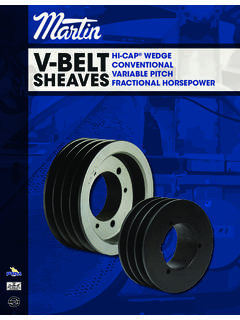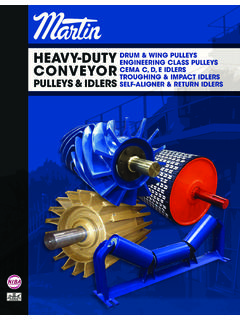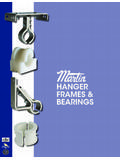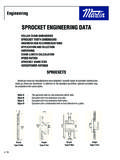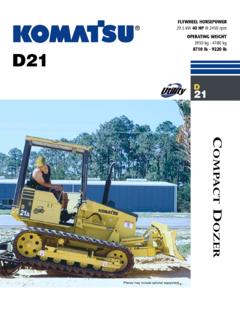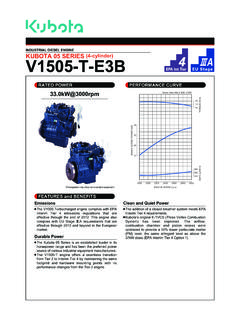Transcription of Martin Gear Manual - martinsprocket.com
1 gear MANUALP ublished by MartinSprocket & gear , Walton, Technical AdvisorMartin2 Introduction ..1 Work ..2 Power ..2 horsepower ..2 Mechanical Advantage ..2 Torque ..2 Simple Machines ..2 Levers ..2 Wheel & Axle ..2 Pulley ..3 Incline Plane ..3 Screw ..3 Wedge ..4 Torque to horsepower ..4 Radian ..4 gear Drives ..5 History ..5 Lubrication ..6 Involute Curve ..7 Pressure Angle ..7 Rotation ..7 Principles of Gears ..7 Types of Gears ..7 Shaft Centers Parallel ..7 Spur Gears ..7 Helical Gears ..8 Herringbone Gears ..8 Internal Gears ..8 Shaft Centers Not Parallel ..9 Bevel Gears ..9 Miter Gears ..9 Spiral Gears ..9 Hypoid Gears ..10 Worm Gears ..10 Rack & Pinion Gears ..10 Parts & Nomenclature.
2 11 Pitch Circle ..11 Pitch Diameter ..11 Pitch (Diametral Pitch) ..11 Circular Pitch ..12 Addendum ..12 Dedendum ..12 Working Depth ..12 Whole Depth ..12 Clearance ..12 Ratio ..12 Rotation ..13 Backlash ..13 General Formulas ..13 American Stub Tooth Calculations ..14 Fellows Stub Tooth ..14 American Standard ..14 American Stub ..14 Fellows Stub ..14 Spur gear Dimensional Formulas ..15 horsepower & Torque Ratings ..16-23 Worm and Worm Gears ..24 Worms ..24 Worm Gears ..24 Trigonometric Formulas ..25-27 Pitch ..28 Efficiency ..30 Self Locking ..30 Formulas for Worm Gears ..31 Bevel Gears ..32 Mounting Distance ..33 Bevel gear Nomenclature ..34 Relative Rotation Thrust ..34 Bevel & Miter gear Ratings.
3 35-36 Direction of Thrust ..36 Miter Gears ..38 horsepower Ratings ..39 Steel ..39 Helical Gears ..40 Parallel Shafts ..41 Pitch ..42 Approx. Ratings of HP transversed DPHelical Gears on Parallel Shafts ..43-44 gear Tooth Wear and Failure ..45 Surface Deterioration ..45 Normal Wear ..45 Abrasive Wear ..45 Scratching ..45 Overload ..45 Ridging ..45 Plastic Yielding ..45 Rolling & Scuffing ..45 Peening ..45 Rippling ..45 Welding ..45 Slight Scoring ..46 Severe Scoring ..46 Surface Fatigue ..46 Initial Pitting ..46 Destructive Pitting ..46 Electrical Pitting ..46 Spalling ..46 Corrosive Wear ..46 Burning ..46 Interference ..46 Grinding Checks ..47 Tooth Breakage ..47 Overload Breakage.
4 47 Fatigue ..47 Cracking ..47 Glossary ..48-50 Spur gear Data Sheet ..51 Rack gear Data Sheet ..52 Bevel gear Data Sheet ..54 Miter gear Data Sheet ..54 Worm gear Data Sheet ..55 Helical gear Data Sheet ..56 Index ..57 TABLE OF CONTENTSM artinINTRODUCTION1 Mechanical power transmission is a necessity because the availableforce can seldom be used in industrial applications without being trans-ferred, reduced or transmission components must be applied and power transmittedto provide the speed and torque at the point of the basic laws formulated by Issac Newton 300 years ago simplifiedthe science of LAW OF MOTION A body at rest remains at rest, and a body in motion continues to moveat a constant speed in a straight line unless compelled to change by someexternal force.
5 (This characteristic is called inertia. Both acceleration anddeceleration require overcoming the inertia of an object.)SECOND LAW OF MOTION The acceleration of a body is in the direction of, and proportional to,the force that produces it, and is inversely proportional to the mass of thebody. (This tells what happens when a force is applied to a moving change which any force makes in the motion of a body depends ontwo things. One is the size of the force, and the other is the mass of theobject. The greater the force, the greater the acceleration. The greater themass the smaller the acceleration.)THIRD LAW OF MOTION For every action there is an equal and opposite reaction. FORCE:The pressure of any body against another body.
6 When theapplied force exceeds the resistance of the objects, motion is the is measured in tons, pounds, ounces, grams, kilograms, POWER TRANSMISSION FUNDAMENTALSM artinWORK:When force moves a body a measured distanceprovided the motion is in the direction of the (work) = Force (lbs.) X Distance (ft.)The energy of a body may be defined as the abilityof a body to do work. The potential energy of abody is its ability to do work by virtue of its positionor condition. Kinetic energy of a body is it s abilityto do work by virtue of its A clock s weights have potential energy equalto the work they can do by running the clock as A flywheel on a punch press has kinetic energywhich provides the work being done on each strokeof the :Rate of doing work or amount of work done perunit of = Work or Force XDistanceTimeTimeHORSEPOWER: With the development of the steam engine Watthad to have a common equalizer to compare theamount of power produced.
7 Most of the engineswere sold for mine pumping. Draft horses were usedprimarily to keep the mines pumped out. Watt exper-imented with horses and found one horse could lift33,000 per minute continuously for a (HP) = Force (lb.) X Distance (ft.)33,000 X Time (min.)HP =F X FPMorFXDistance (per second)33,000550 MECHANICAL ADVANTAGE:By using machines or mechanical devices, a small-er force can be made to do the work of a =Fo (large force)Fa (small force)Since we do not get something for nothing, thesmaller force must act through a greater distancethan the larger : The twisting or turning effort around a shaft tend-ing to cause rotation. Torque is determined by multi-plying the applied force times the distance from thepoint where force is applied to the shaft = F (force) X R (Radius)SIX BASIC SIMPLE MACHINES1.
8 Lever*2. Pulley3. Wheel & Axle4. Inclined plane*5. Screw6. Wedge* Six machines are actually only two typesLEVERS:There are three classes of levers depending on theposition of the 1:The fulcrum is between the force or effort,and resistance. Case 2:The fulcrum is on the end and the resist-ance is between the fulcrum and the force. Example of a wheel barrowRFEABRFEABE xample of a crowbar2 MartinINTRODUCTIONCase 3:The force is applied between the fulcrum and the of tweezers or Case 1 and Case 2 the force needed to move theobject is less than the weight of the object. Liftingability is gained at the expense of speed. In Case 3the force must be greater than the weight of theobject being moved. The gain is one of AND AXLE: The greatest event of power transmission historywas the invention of the wheel.
9 With the wheel camethe invention of the : The first kind of pulley was the fixed pulley. It hasno mechanical advantage, it only changes the direc-tion of second kind, by adding a moving pulley, cutsthe effort in half to do the required work. Themechanical advantage is equal to the number ofstrands actually pulling the PLANE:The mechanical advantage is the length of theincline divided by the vertical = Load X Length of Incline (LI)Height (H)SCREW:A form of inclined plane. The mechanical advan-tage is the ratio of the circumference of the screw tothe distance that the loadadvances during one = Load 2 r X PitchRFEABF orce x A = Load x BMechanical advantage = ABFRAMEOR BLOCKAXLEORAXISWHEELORSHEAVEAXISRESISTAN CE EFFORTCFIXEDEMOVEABLERM echanical Advantage 6 to 1 Mechanical Advantage 4 to 1 Distance To TravelHeightLength of InclineRPitch3 MartinINTRODUCTIONWEDGE:Another form of inclined OF TORQUE TO HORSEPOWERTQ (in/lb) =HP x 63025orRPMHP =TQ (in/lb) x RPM or63025HP = TQ (ft/lb) x 63025= 52525252 12TQ (ft/lb) = HP x 5252 RPMTo figure percent of loss or gain.
10 Loss = Original number - new numberX 100 = %Original numberGain = New number - Original numberX 100 = %Original numberTo find the circumference of a circle:C = Diameter X ( = )DEFINITION OF RADIANThe angle of the radius of a circle scribed on anarc of the circumference. A radian is . It radians to make a complete Surface of arcr= Radius of circle = RadiansS= r NOTE: By definition workis equal to force times distance on a convert use W = F X D X T to circular Work = Force X (D) x RPMS ample Problem:Find the work involved in a sprocket drive when asprocket has a 12 pitch diameter with a chain forceof 500 lbs. turning 150 RPM. Also find the work,linear velocity, and horsepower needed to turn = F X DW = F X d X RPMW = 500 lbs.
